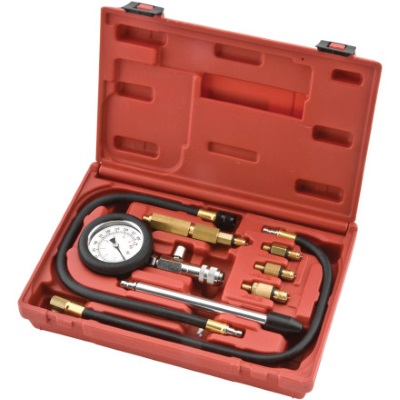
Much like the human body a dirt bike often rides well, sounds fine and by all accounts performs in great shape. Until you look under the hood, so to speak, and perform some diagnostics.
Little did you know, it was falling apart on the inside. An ounce of prevention is worth a pound of cure as they say, therefore a compression test provides the best way to determine if your dirt bike or ATV engine is on the ropes. Don't worry, it's relatively non-intrusive and you don't need an appointment with a professional. An affordable, at-home compression tester helps demonstrate the condition of the valves, seals and piston. Fundamentally, it shows whether or not rebuilding the top end is in your future.
Conducting routine compression tests helps the avid racer determine if the engine is ready for the next Moto or scramble. Practice laps went fine but as the engine turns weaker sooner or later you lose enough power and that edge to beat the other guy and reach the podium.
And, like routine human tests it is good practice to keep records of the compression test scores so you can watch for any patterns of weakness. Ideally, you measure compression when your dirt bike is new and record follow-ups as you put hours on. Once you perform a full top end or even just a new piston and rings, note the new compression numbers and keep track as you add hours.
A compression tester is a daunting looking device with lots of hoses and fittings. But it's not as hard as it looks and the test takes less than 10 minutes. Access to the cylinder head is required so you might have to remove the gas tank. (On a 2-stroke turn the petcock off.) Remove the spark plug and attach the applicable adapter from the compression kit to the cylinder head (that's one reason for all the included fittings in the kit). Tighten, no need for any tools, just finger tighten by spinning the tester hose until tight.
A Compression Test is pretty easy to perform - just thread it into the spark plug hole on the cylinder head
Once attached, open the throttle (and keep it open) and kick start the engine over and over until the compressor gauge reaches peak pressure. Record the results. Remember, the engine doesn't actually start - no spark plug. Opening the throttle opens the slide on the carb or butterfly on the throttle body pulling air into the engine to compress. It also relieves back pressure and a vacuum that develops while cranking from the intake side that sometimes creates inaccurate test results.
If you have an electric start remember to keep the engine switch turned to the "On" position. When ready, open the throttle, press the start button and watch the compressor gauge. Check the owner's manual of your bike for ideal engine pressure but generally speaking a healthy 250cc 2-stroke engine shows compression ranges from 170 to 240 psi and all other engine sizes between 120 and 190.
A BikeMaster Compression Tester
On 4-strokes, the service manual specific to the bike make and model provides the required compression range as well as information on whether you need to deactivate the compression relief system. Briefly, this compression relief system opens one of the exhaust valves to make kickstarting easier. Once disabled (if necessary) you follow the directions above for compression testing.
Any compression numbers below the accepted range or significant drops from the last compression test means it's time for a top end. Using a compression test prevents a number of future mechanical issues and gets you in the habit of maintenance. Think of it this way - Is it better to find out the need for a top end now or after the bike breaks down? Some riders use the ease of a compression test to keep track of long term maintenance and how regular checks fare with past neglect or prior dirt bikes not routinely tested.
Lastly, owners of 4-strokes should complete a Leak Down Test if a compression test indicates low compression. Worn valve seats, heavily developed pitting, carbon build up, cracked valves loose or worn valve guides as well as a number of related things also cause low compression symptoms the compression test cannot analyze.
Owners of 4-stroke bikes can skip the compression test for the Leak Down Test however you won't get the actual read-out a compression test offers. A compression tester is affordable and most riders who don't already have one probably know a fellow rider who does. The relatively uncomplicated nature of using one make it an easy first step in diagnostics. However, if your 4-stroke bike requires deactivating the compression relief system you might find it easier to skip the compression test and head right into the Leak Test. It's a bit more complicated but easily done at home for the mechanically-inclined.










